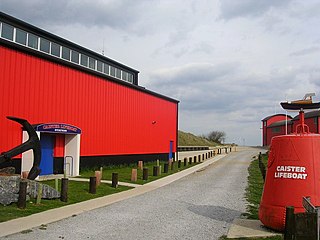Caister-on-Sea, also known colloquially as Caister, is a large village, seaside resort and civil parish in the English county of Norfolk.

Henry George Blogg GC BEM was a lifeboatman from Cromer on the north coast of Norfolk, England, and the most decorated in Royal National Lifeboat Institution (RNLI) history.
James Henry Haylett (1825–1907) was one of the most famous lifeboatmen of his age. Decorated by King Edward VII with the RNLI Gold Medal for his efforts in the 1901 Caister lifeboat disaster, which claimed the lives of nine men. Amongst those lost were two of his sons, Aaron and James Haylett, Charles Bonney George and his grandson Harry Knights.

Caister Volunteer Lifeboat Service, or Caister Lifeboat, is based at Caister-on-Sea in Norfolk, and operates one of only three offshore lifeboats in the UK that are independent of the RNLI.

RNLB Louisa Heartwell was the sixth lifeboat to be stationed at Cromer on the coast of the English county of Norfolk She was launched from the beach station and was on station from 1902 to 1932. During her period on station at Cromer the Louisa Heartwell had only two coxswains during her 29-year career. They were Matthew James Buttons Harrison until his retirement in 1909, and then Henry George Blogg.

SS Monte Nevoso was a cargo steamship that was launched in 1920 in England, owned in Italy, and wrecked in 1932 in the North Sea off the coast of Norfolk.
SS Gallois was a French collier built in 1917 as Tynemouth and later Lord Aberconway. She was one of seven merchant vessels which became stranded and then wrecked on Haisbro Sands off the Norfolk coast on 6 August 1941 during the Second World War as part of Convoy FS 559.

Alf was a three-masted Norwegian barque which became stranded and then wrecked on 23 November 1909 on Haisbro Sands, off the coast of Norfolk. She was originally built in 1876 as Inchgreen for Scottish owners. In the 1890s she was sold to Danish owners and renamed Adolph Harboe. Around the turn of the 20th century she was sold to Norwegian owners and renamed Alf, serving until she was wrecked off the coast of Norfolk.
SS Hopelyn was a merchant ship from Newcastle that became stranded and then wrecked on Scroby Sands of the Norfolk coast on 17 October 1922.

The Manchester Unity of Oddfellows was an Oakley-class lifeboat of the Royal National Lifeboat Institution (RNLI) stationed at Sheringham in the English county of Norfolk from 10 July 1961 until 1990 when she was replaced after 29 years service by an Atlantic 75 second generation Rigid Inflatable Boat (RIB) in May 1992. During the time that The Manchester Unity of Oddfellows was on station at Sheringham, she performed 127 service launches, rescuing 134 lives.

RNLB J C Madge was a Liverpool-class, Pulling and Sailing non-self righting lifeboat stationed at Sheringham in the English county of Norfolk from December 1904 until June 1936 during which time she was launched on service 34 times and saved 58 lives. J C Madge was replaced by Forester’s Centenary.

Wells-next-the-Sea Lifeboat Station is located at the end of Beach Road, about 1 mi (1.6 km) north of the town of Wells-next-the-Sea, on the north coast of the English county of Norfolk.

Aldeburgh Lifeboat Station is located in the town of Aldeburgh, in the English county of Suffolk.

RNLB Foresters Centenary is a retired Liverpool-class lifeboat of the Royal National Lifeboat Institution (RNLI), stationed in the English coastal town of Sheringham in the county of Norfolk in the United Kingdom. The lifeboat was on station for 25 years between 1936 and 1961 when she was sold. She has been restored to her original condition and is exhibited in Sheringham Museum.

Henry Ramey Upcher was the second private lifeboat to be stationed in the English town of Sheringham in the county of Norfolk. She was launched on 4 September 1894 and stayed on station for 41 years until she was slowly retired from duty and by 1935 had ceased rescue work completely. The lifeboat is now on permanent display in her converted original boat shed.

Happisburgh Lifeboat Station is a Royal National Lifeboat Institution (RNLI) Inshore lifeboat station close to the village of Happisburgh in the English county of Norfolk in the United Kingdom. Since 2003 the station boathouse has been re-located from the village to an area south called Cart Gap. This is because the beach below Happisburgh disappeared due to coastal erosion and the stations slipway and access was washed away. The original boathouse in the village is now used for training.

Eastbourne Lifeboat Station is a Royal National Lifeboat Institution (RNLI) lifeboat station in the town of Eastbourne in East Sussex. Founded two years before the RNLI was established, the station has operated continuously since 1822, and its lifeboats have been responsible for saving over 700 lives.

Hendon Beach Lifeboat Station was located on the coast between the Wearside and Grangetown areas of Sunderland, in the county of Tyne and Wear.

Caister Lifeboat Station is located in the village and seaside resort of Caister-on-Sea, on the east coast of the county of Norfolk.

Hythe, Sandgate & Folkestone Lifeboat Station was located off Princes Parade, Seabrook, at the eastern end of the Royal Military Canal, midway between Hythe and Folkestone, in the county of Kent.
















